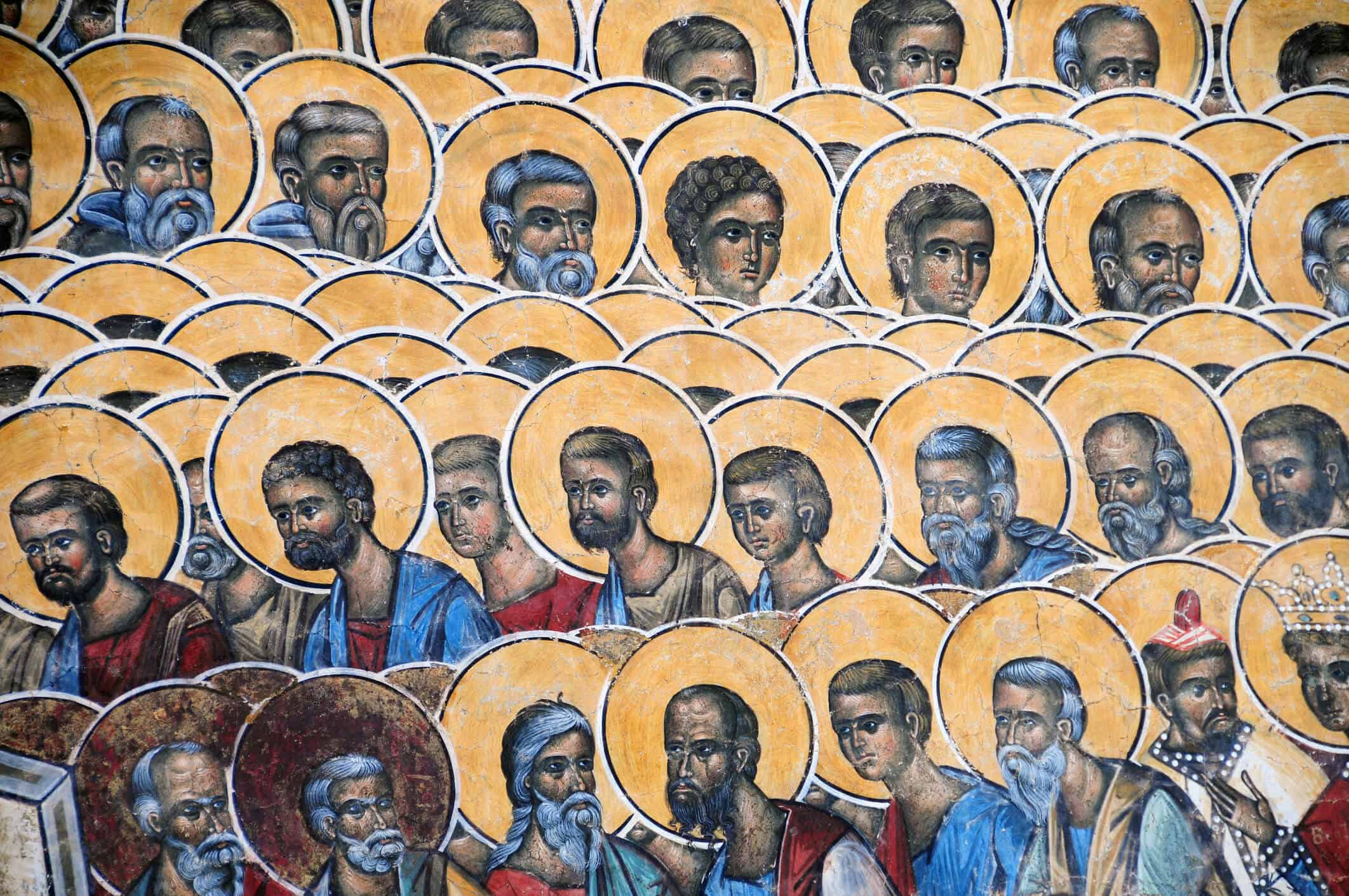April 1
Bl. Karl of Austria
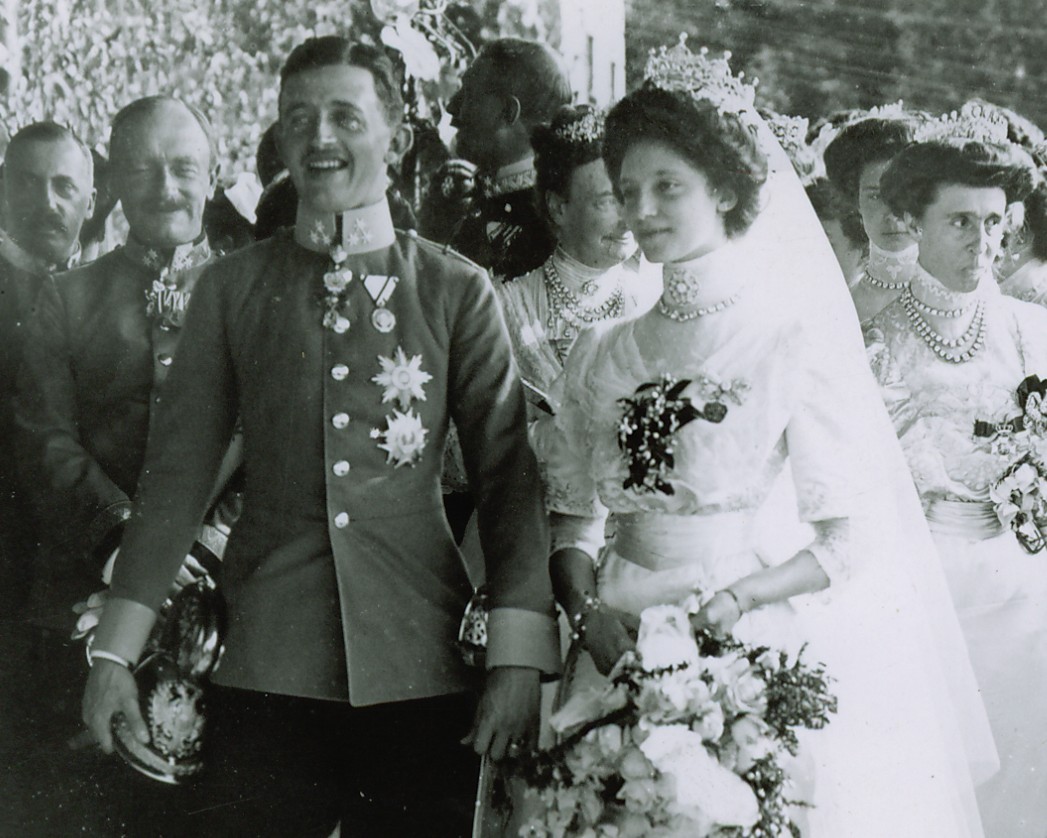
“Thy Holy Will be done. Jesus, Jesus, come! Yes—yes. My Jesus as Thou willst it—Jesus.”
Bl. Karl of Austria
(The last words of Bl Karl – 1 April 1922)
Karl of Austria was raised in a faithful home. From a young age and throughout his life, Karl of Austria demonstrated an awareness of God’s presence and Christian duty. He developed deep devotions to the Blessed Sacrament and the Sacred Heart. As a child, he submitted all his decisions to God in prayer, and throughout his life he loved to pray. As a youth and later as an adult, he enjoyed making pilgrimages to Marian shrines. There are records from when he was 18 years old recording his almsgiving, and even as Emperor he continued his private charitable giving.
Karl proposed to Princess Zita of Bourbon-Parma in front of the Blessed Sacrament at the Marian Shrine of Mariazell. They married in 1922 and the day after their marriage, Karl told his bride: “Now we must help each other get to heaven.” Karl and Zita had a loving relationship, and were each other’s soul mate. They were devoted to each other, supported each other, and had the same Christian values. Their children were brought into this loving environment, and each child was cherished as a gift from God. In eleven years, eight children were born to them. Husband and wife were both concerned to educate them in the faith.
The event that ignited World War 1, the assassination of Archduke Franz Ferdinand on June 28, 1914, also put Karl in line for the thrones of Austria and Hungary. In 1916, in the midst of the war, Karl became Emperor of Austria and King of Hungary. From the first, he focused his efforts on reducing conflict. He was the only world leader at the time to integrate Pope Benedict XV’s recommendations for peace. He established a Ministry of Social Welfare-the first of its sort in the world. He organized soup kitchens, used the palace’s horses and wagons to deliver coal to the Viennese, fought against usury and corruption, and gave away most of his private wealth by distributing alms beyond his means.
After the war, Karl was unable to reclaim the throne of Hungary, due, in part, to his efforts to avoid civil war. His countrymen reacted by arresting him. In 1921, he and his family were exiled to the island of Madeira. The stress of the move and the dramatic change in circumstances took its toll, and Karl died of pneumonia less than five months later. He explicitly accepted his death for the sake of peace among his people. Karl offered his illness and suffering as a sacrifice for the peace and unity of his lands: “I must suffer like this so my people will come together again.”
April 4
St. Isidore of Seville
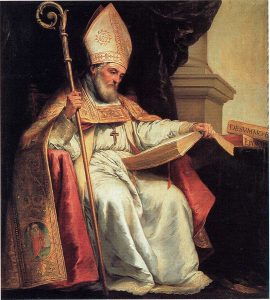
“If a man wants to be always in God’s company, he must pray regularly and read regularly. When we pray, we talk to God; when we read, God talks to us.”
St. Isidore of Seville
Isidore was born in 6th century Cartagena, Spain during complex political times; with the country split between Catholic Spaniards and Arian Visigoths. He came from a pious family (three of his siblings were also saints) and assisted his brother St. Leander in converting the Arian Goths to Catholicism, reuniting the country.
Isidore was originally a poor student, but at an early age he gave his issue over to God. He subsequently developed into an amazing scholar, and is still known as “The Schoolmaster of the Middle Ages”. His exceptional classical education formed him into a prolific author. He wrote a Rule for religious orders, a dictionary, a history of the Goths, a history of the world, and an encyclopedia of knowledge, the Etymologiae. That work was an encyclopedia of universal knowledge, which gathered in one place many Roman and other classical documents, which would otherwise have been lost. It served as a reference for 900 years.
He was ordained Bishop in 599, replacing his brother Leander upon the latter’s death. His main goal as bishop was to continue the work of both his parents and his older brother to counteract Gothic barbarism by melding it with the remaining Roman culture. His continued efforts met with great success. He struggled between the life of solitude to meditate on the Word of God and the demands of ecclesiastical duties. He organized synods to discuss representational government that became the model for European nations. He founded numerous schools and seminaries, and was responsible for introducing Aristotelian philosophy to Spain; St. Isidore promoted education by encouraging seminaries and schools built in every diocese.
His liturgical and theological writings caused him to be named a Doctor of the Church; he is sometimes referred to as the patron saint of computer users and the Internet. His last dying act was to give away all his possessions.
April 7
St. John Baptist de la Salle
Saint John Baptist de la Salle was born to a noble family in Rheims, France, the oldest of 10 children. He took the degree of Master of Arts at the age of 18 and began studying for the priesthood in Paris, but left to care for his younger four brothers and two sisters upon the death of his parents. After his siblings were grown, he returned to his studies, and was finally ordained to the priesthood in 1678 and received his Doctor of Theology degree two years later. He distinguished himself by his piety and intellect.
At that time, he was appointed to be the spiritual director of the Sisters of the Holy Infant, a religious order devoted to the sick and to teaching poor girls. He became involved with starting a school for the poor in Rheims, and began assisting the young men who taught in Rheims, actually inviting them to live in his house while they taught. In 1681 he founded the Brothers of the Christian Schools (Christian Brothers or La Salle Brothers), the first religious institute for laymen. That order of consecrated laity supported the idea of an academic education for all boys, at a time when education was only for the upper class. When he liquidated his personal fortune in 1683, he kept enough of the proceeds to pay himself a salary commensurate with that of the Brothers, so as not to be a burden on them. The rest he used for feeding the poor in Champagne during the great famine of that year.
During his lifetime he instituted many reforms, some of which we see still in use today. He divided students into grades, used classroom teaching rather than individual instruction, and replaced Latin with the vernacular in teaching subjects. He offered Sunday classes for young men who worked during the other six days and he founded one of the first reform schools in France. Since his death, the Lasallian order has grown to about 3,000 Brothers, who help in running over 1,100 education centers in 80 countries, with the help of 90,000 other teachers and lay associates.
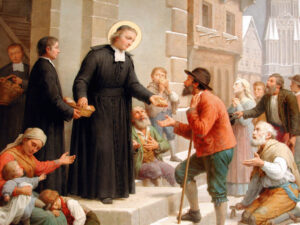
“Take even more care of the education of the young people entrusted to you than if they were the children of a king.”
St. John Baptiste de la Salle
April 11
St. Gemma Galgani
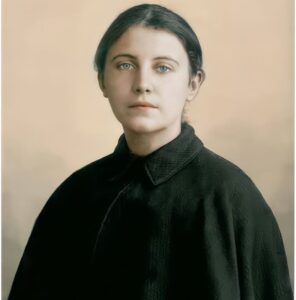
“What do You wish, Oh Jesus? My life? It is Yours…..I have already offered it to You. Would You be pleased if I offered it as a victim, in reparation for my sins, and those of all sinners? If I had a hundred lives, I would give every one of them to You!”
St. Gemma Galgani
The fourth of eight children born to a well-to-do pharmacist and his wife, Gemma was by all accounts an intelligent and devout child. After losing her mother to tuberculosis at the age of eight, she went to the Sisters of Saint Zita for an education. When her father died, he left the family in financial straits, and nineteen-year-old Gemma became responsible for her younger siblings. Shortly after this, Gemma contracted a serious paralyzing disease, most likely meningitis.
Yet her prayer life kept pace with her suffering, and at the beginning of a novena, she saw the young Passionist Saint Gabriel Possenti in a vision, who came to pray it with her every evening. Gabriel promised healing and foretold that a special grace would be conferred on Gemma.
Throughout her life, Gemma was to be favored with many mystical experiences and special graces. Gemma often saw her guardian angel, with whom she was on familiar terms and sent on errands. On June 8, 1899, she received the stigmata, the marks of Christ’s wounds in her own flesh. This alienated some of her own family members, but her spiritual director undertook a thorough investigation and stood by her. She wished to become a nun, but her poor health prevented her from being accepted.
At the age of twenty-five, Gemma contracted tuberculosis. After much suffering, she died quietly in the company of the parish priest, on April 11, 1903. Moved by her witness, Passionist nuns founded a convent in her hometown soon after her death. Gemma’s letters give witness to her great desire for Christ: “I shall love you, I shall love you always; when day breaks, when evening turns into night, at every moment.”
April 11
St. Stanislaus of Cracow
Stanislaus was born of Polish nobility near the city of Cracow. After the death of his parents, he distributed his inheritance to the poor and was ordained as a priest. He was elected bishop of Cracow in 1072 and the example of his devout life and his preaching led to the conversion of many of his penitents. He was a vociferous critic of sinful living, criticizing peasants and royalty equally. He confronted King Boleslaus the Cruel over his seizure of church lands, his unjust wars and his immoral living. Although Boleslaus initially repented, his backsliding brought intense criticism from Stanislaus, despite charges of treason and numerous death threats. When Stanislaus finally excommunicated him, an enraged Boleslaus murdered him with his own hands at the altar as he said mass.
With John the Baptist, Thomas More, Thomas Becket, and Oscar Romero in their own times, Stanislaus showed the prophetic courage required to stand against the excesses of those in power.
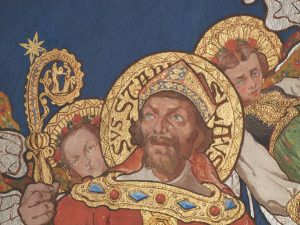
April 16
St. Bernadette Soubirous
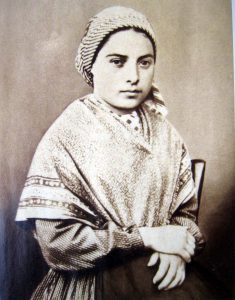
Bernadette Soubirous was born in 1844, the oldest child of an extremely poor miller. She was a poor student and her health was fragile when, at the age of 14, a young lady appeared to Bernadette. The lady instructed Bernadette to return to the grotto, where she appeared to the young peasant girl a total of 18 times. At one of these times, the lady instructed Bernadette to dig in a certain spot where a spring streamed forth. Almost immediately cures were reported by those who drank there.
During the apparition on March 25, the lady identified herself as the Immaculate Conception. Having only a very rudimentary knowledge of her faith, she did not understand the term, but reported it to her parish priest. Bernadette reported the desire of the lady that a chapel should be built at the grotto. In 1862 Church authorities confirmed the authenticity of the apparitions and authorized the worship of Our Lady of Lourdes.
During her life, Bernadette was hounded by the public until at last she fled to a hospice school of an order of nuns. Five years later, she joined the Sisters of Charity in Nevers where she served as sacristan and infirmarian until her death from tuberculosis in 1879, at the age of 35.
“The Blessed Virgin used me like a broom. What do you do with a broom when you have finished sweeping? You put it back in its place, behind the door!”
St. Bernadette Soubirous
April 23
St. George
One of the Fourteen Holy Helpers, George is one of the most famous saints in Western Europe. He was thought to be a Roman officer of Greek descent from Cappadocia who served in the Praetorian Guard and was beheaded during the reign of the emperor Diocletian for refusing to recant his faith. This happened during Diocletian’s persecution of 303AD, aimed at Christians among the professional soldiers of the Roman army. There is no reason to doubt the historicity of St. George, although there is no historical evidence of many of the tales told about him.
Legends of St. George’s deeds were incorporated into the medieval account of the lives of the saints called the Golden Legend, and he became associated with dragons in Italian accounts of his life. The legends concerning dragons arose in the twelfth century and made him a model knight and a protector of women.
George was venerated in England as early as the eighth century and was the patron of the Christian crusaders. The red cross worn by crusaders, later seen in the Union Jack and in the decorations of the Order of the Garter in England, are called “St. George’s Arms.” The Order of the Garter has been under his patronage since its founding in 1347. The cult of St. George is part of the history of the crusades and England. He has been a popular figure for artists, depicted as a young knight in mortal combat with a dragon, a Middle Ages symbol of evil. The “Arms” of St. George are a red cross in a white ground.
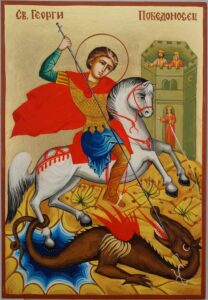
“As for Saint George, he was consumed with the fire of the Holy Spirit. Armed with the invincible standard of the cross, he did battle with an evil king and acquitted himself so well that, in vanquishing the king, he overcame the prince of all wicked spirits, and encouraged other soldiers of Christ to perform brave deeds in his cause.”
St. Peter Damian
April 25
St. Mark
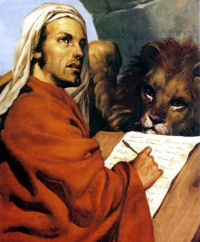
Like one of the other Gospel writers (Luke), St. Mark was not one of the original 12 apostles. We can’t be sure whether or not he ever encountered Jesus personally. But what we are certain of is that he was a missionary companion of his cousin, St. Barnabas and St. Paul, and a close friend of St. Peter, who called him “my son”. When Saint Peter escaped from prison, he went to the home of Mark’s mother.
Mark’s Gospel is the oldest and shortest of the four Gospels. Mark’s Gospel was probably written between 60 and 70 A.D., and was based upon the teachings of St. Peter. It is believed Mark provided both Luke and Matthew with basic sources for their Gospel’s. He is held to be the first bishop of Alexandria, Egypt; and is claimed as its patron by the city of Venice.
April 28
St. Gianna Beretta Molla
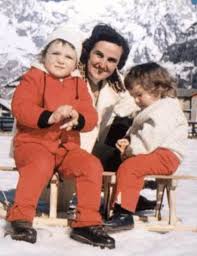
Gianna Beretta was born near Milan in 1922, the tenth of thirteen children. Growing up, she became a devout and prayerful young woman, active in the Society of St. Vincent de Paul and the Catholic Action movement. She studied medicine in university, with a specialty in pediatrics, and opened he own medical practice in 1949.
Gianna met Pietro Molla, who worked in her office, and in 1955 the two were married. The couple had three children, and, sadly, suffered two miscarriages. Early during her 6th pregnancy, doctors discovered a large ovarian cyst. She allowed her surgeon to remove the tumor itself, but refused an abortion and a hysterectomy which were necessary to save her life, but which would have ended the life of her child.
On April 21, 1962, her daughter Gianna Emanuela Molla was successfully delivered by Caesarean section. A week later, Gianna Beretta died from complications. She was canonized in 1994 during a ceremony attended by her husband and her children. Today, her daughter Gianna Emanuela Molla is a physician herself, and involved in the pro-life movement.

